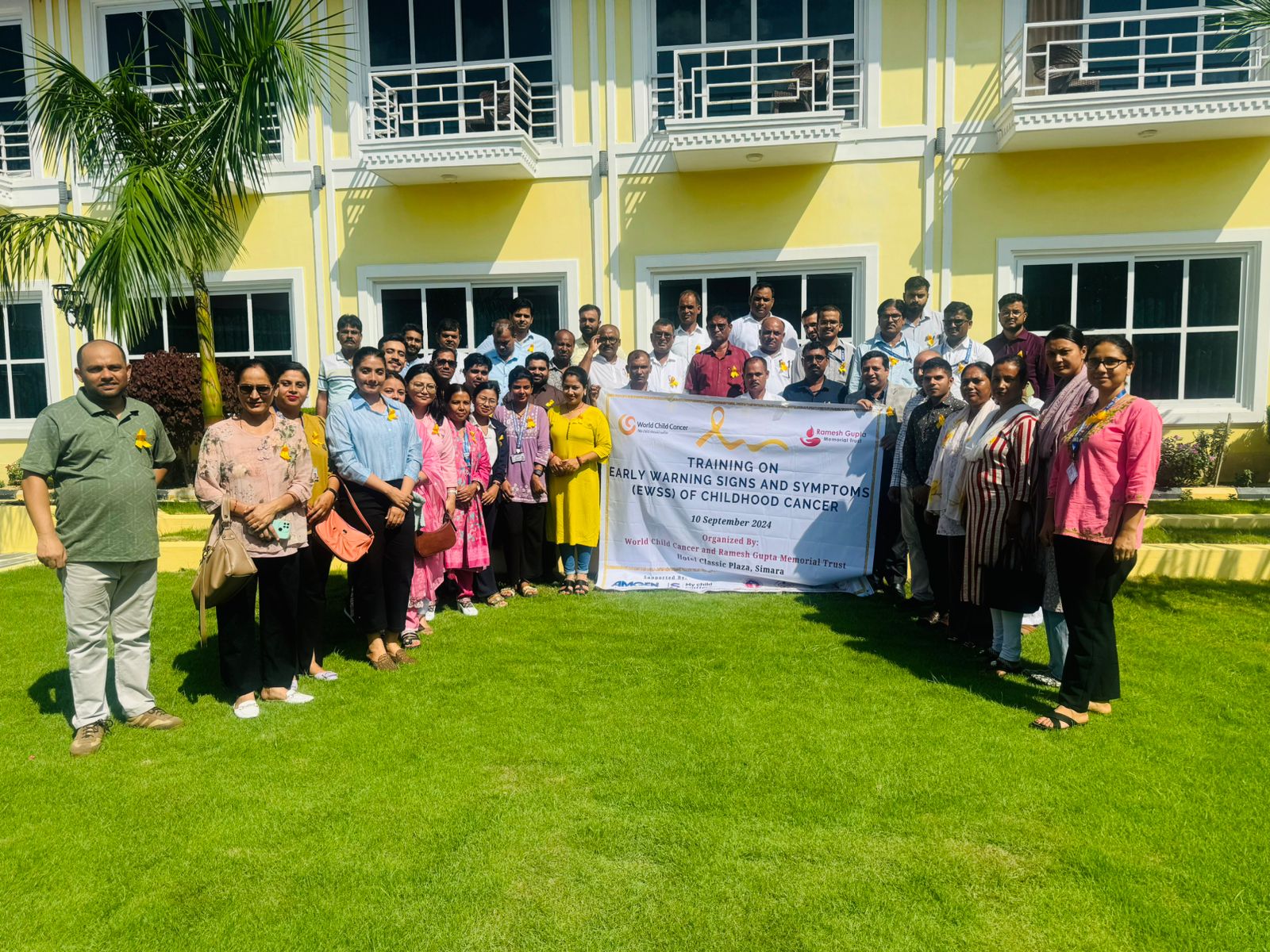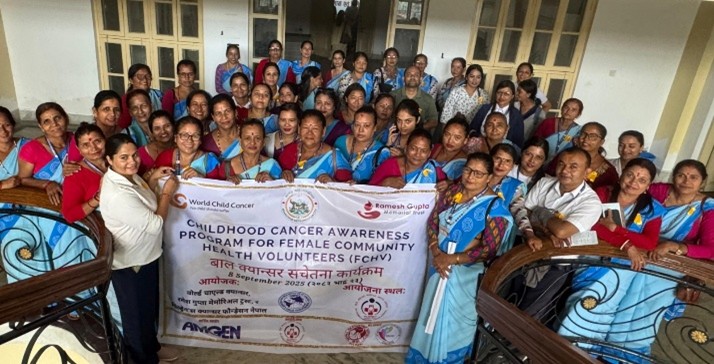Identifying Early Warning Signs and Symptoms (EWSS) of Childhood Cancer: A Report from Simara, Madhesh Pradesh of Nepal
Childhood cancer may not be preventable, but early detection greatly improves the chances of successful treatment. One key factor contributing to the difference in outcomes between high-income and low-income countries is the delay in diagnosis and treatment.
When cancer is diagnosed late, it often means the disease has reached an advanced stage, making treatment more difficult and reducing the likelihood of a positive outcome.
To tackle this challenge and improve early detection, a training session was held in Simara, Madhesh Pradesh with the main objective of raising awareness among local healthcare providers about the early warning signs and symptoms of childhood cancer. By empowering health professionals with the knowledge to spot these signs early, we aim to ensure quicker referrals and better outcomes for patients.
Training:
The training was organized by the Ramesh Gupta Memorial Trust (RGMT) with technical support and coordination from Patan Academy of Health Sciences, Patan Hospital, BPKMCH Bharatpur, Chitwan, and Together Against Childhood Cancer (TACC), and financial support from World Child Cancer (WCC) & Amgen.
Similarly, the Health Directorate of the Madhesh Pradesh Government helped coordinate the timing, location, and participants. The session took place at Hotel Classic Plaza in Simara on 10th September 2024.
Trainers:
1. Dr. Krishna Sagar Sharma: Senior Consultant Pediatric Oncologist, BP Koirala Memorial Cancer Hospital, Bharatpur
2. Dr. Sucharita Tuladhar: Consultant Pediatric Oncologist, Patan Academy of Health Sciences, Patan Hospital
3. Namita Bharati: Senior Pediatric Nurse, Patan Academy of Health Sciences, Patan Hospital
4. Prechan Thapaliya, Pediatric Oncology Nurse, BP Koirala Memorial Cancer Hospital, Bharatpur.
Invited participants:
- Director/Representative from Health Directorate, Madhesh Provincial Government
- Chief/Representative from District Health Offices
- Pediatricians from Narayani Hospital, Birgunj, Pokhara Hospital, Gaur Hospital and Hetauda Hospital
- Medical officers and nursing Staff from Primary Health Care Centers of Rautahat, Bara, Parsa, and Hetauda districts
- Head of Health posts from different health offices of Rautahat, Bara, Parsa, and Hetauda districts.
A total of 47 participants, facilitators, and supporting staff attended the training. Invitations were sent through a formal letter from the Ramesh Gupta Memorial Trust to the Health Directorate of Madhesh Pradesh, along with phone calls to ensure participation.
Contents of the training
The one-day orientation training was conducted in an engaging and welcoming manner, with participants eager to learn and apply the knowledge gained.
The trainers and the sessions covered were as follows:
| Sessions | Trainer |
| Introduction and Overview of Training | Dr. Krishna Sagar Sharma |
| Basic Concepts of Cancer and Pediatric Oncology | Dr. Sucharita Tuladhar |
| Common Cancer in Children | Dr. Sucharita Tuladhar |
| Childhood Cancer: Myths and Differences from Adults | Prechan Thapaliya / Dr. Sucharita Tuladhar |
| Early Warning Signs of Childhood Cancer -Fever, Bleeding, Limb Pain/Body Pain, Eye Reflex, Neurologic Symptoms (Focal Deficits), Abdominal Lumps | Namita Bharati/ Dr. Krishna Sagar Sharma |
| Suspicion of Cancer in Children: Presenting symptoms -Fever, Bleeding, Limb Pain/Body Pain, Eye Reflex, Neurologic Symptoms (Focal Deficits), Abdominal Lumps | Dr. Krishna Sagar Sharma |
| Management of Suspected Child with Cancer -Overview of Treatment and Outcome |
Dr. Sucharita Tuladhar |
| Oncology Emergencies: Brief Review TLS, Hematologic, SVC, etc. | Dr. Sucharita Tuladhar |
| Support Systems for Treatment -Government support/ Insurance/ Philanthropic Support/ Other | Dr. Sucharita Tuladhar |
Scores
A pretest and posttest were conducted to assess participants' initial knowledge of childhood cancer and to measure the improvement in their understanding after the training. This approach helped us understand the baseline awareness of childhood cancer among healthcare providers and evaluate how effectively the training enhanced their knowledge of early warning signs and symptoms.
|
| Results | |||
| Participants | Pre-test | Pre-test % | Post-test | Post-test % |
| 1 | 9 | 60% | 14 | 93% |
| 2 | 12 | 80% | 15 | 100% |
| 3 | 11 | 73% | 14 | 93% |
| 4 | 12 | 80% | 15 | 100% |
| 5 | 12 | 80% | 15 | 100% |
| 6 | 10 | 67% | 15 | 100% |
| 7 | 7 | 47% | 12 | 80% |
| 8 | 13 | 87% | 13 | 87% |
| 9 | 10 | 67% | 15 | 100% |
| 10 | 11 | 73% | 15 | 100% |
| 11 | 11 | 73% | 15 | 100% |
| 12 | 7 | 47% | 12 | 80% |
| 13 | 5 | 33% | 14 | 93% |
| 14 | 12 | 80% | 15 | 100% |
| 15 | 6 | 40% | 13 | 87% |
| 16 | 12 | 80% | 15 | 100% |
| 17 | 8 | 53% | 14 | 93% |
| 18 | 7 | 47% | 13 | 87% |
| 19 | 6 | 40% | 13 | 87% |
| 20 | 13 | 87% | 15 | 100% |
| 21 | 9 | 60% | 14 | 93% |
| 22 | 13 | 87% | 14 | 93% |
| 23 | 12 | 80% | 15 | 100% |
| 24 | 12 | 80% | 14 | 93% |
| 25 | 8 | 53% | 13 | 87% |
| 26 | 11 | 73% | 14 | 93% |
| 27 | 10 | 67% | 15 | 100% |
| 28 | 11 | 73% | 15 | 100% |
| 29 | 10 | 67% | 14 | 93% |
| 30 | 8 | 53% | 14 | 93% |
| 31 | 12 | 80% | 15 | 100% |
| 32 | 7 | 47% | 13 | 87% |
| 33 | 12 | 80% | 15 | 100% |
| 34 | 9 | 60% | 13 | 87% |
| 35 | 14 | 93% | 15 | 100% |
| 36 | 8 | 53% | 14 | 93% |
| 37 | 12 | 80% | 14 | 93% |
| 38 | 12 | 80% | 15 | 100% |
| 39 | 11 | 73% | 14 | 93% |
| 40 | 8 | 53% | 13 | 87% |
| 41 | 8 | 53% | 11 | 73% |
| 42 | 7 | 47% | 14 | 93% |
| 43 | 9 | 60% | 15 | 100% |
| 44 | 10 | 67% | 14 | 93% |
Recommendations:
• The coverage should be expanded to include all primary healthcare workers.
• A follow-up session could be beneficial in the future to refresh participants' knowledge.
• A standard operating procedure document could be created to help standardize and streamline the organization and coordination of future training sessions.
• Involving local government representatives in the training could enhance its effectiveness and should be considered for future sessions.
• To raise public awareness, extending the training to the community level through Female Community Health Volunteers (FCHVs) should be explored in future initiatives.
Acknowledgement:
We would like to express our sincere gratitude to Ramesh Gupta Memorial Trust, Dr. Rabi Shakya, Director, Patan Academy of Health Sciences (PAHS), Dr. Shivaji Poudel, Executive Director, BPKMCH, Dr. Anil Ojha, HOD, Department of Pediatrics, PAHS and TACC for guidance & continuous encouragement and financial support we would like to extend our gratitude to World Child Cancer & Amgen. We would also like to thank the Health Directorate, and Madhesh Provincial Government for continuous support, communication, and facilitation with local levels, health workers, and the venue for organizing the training.




